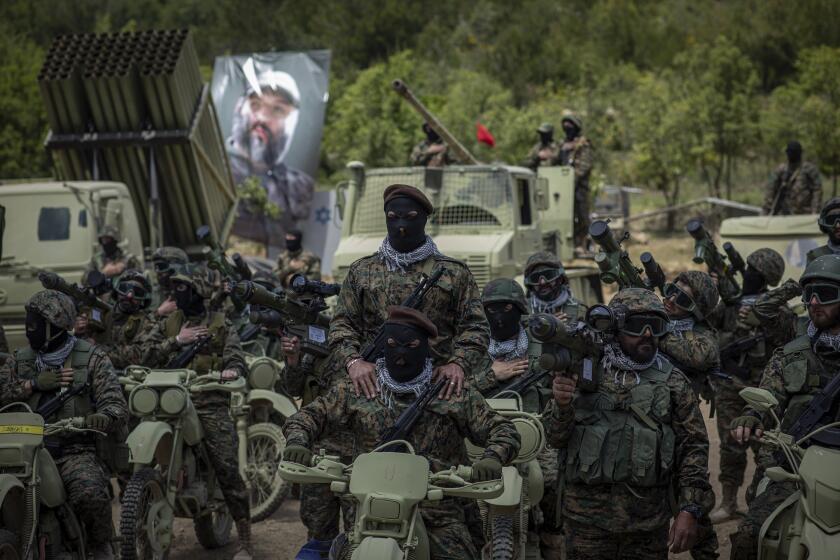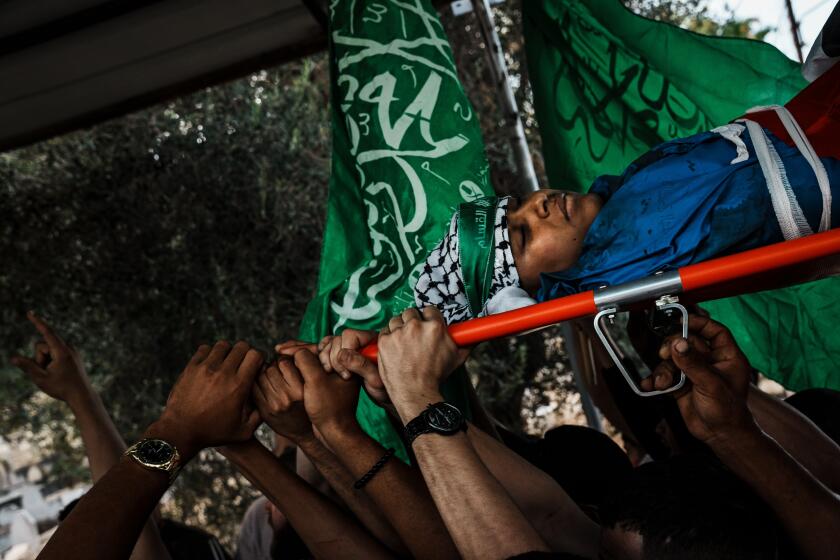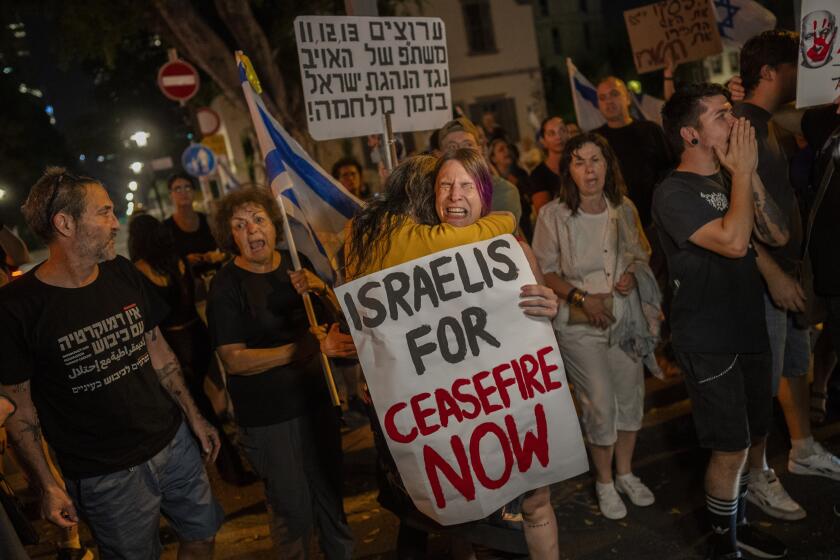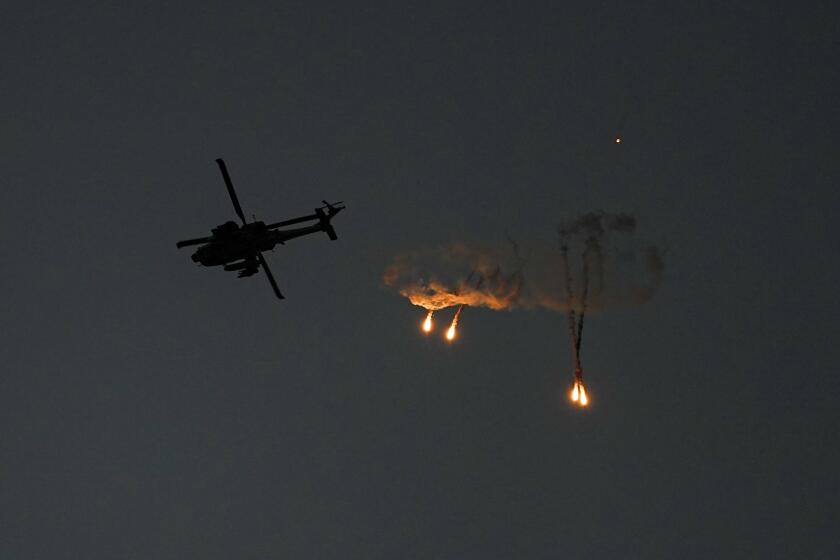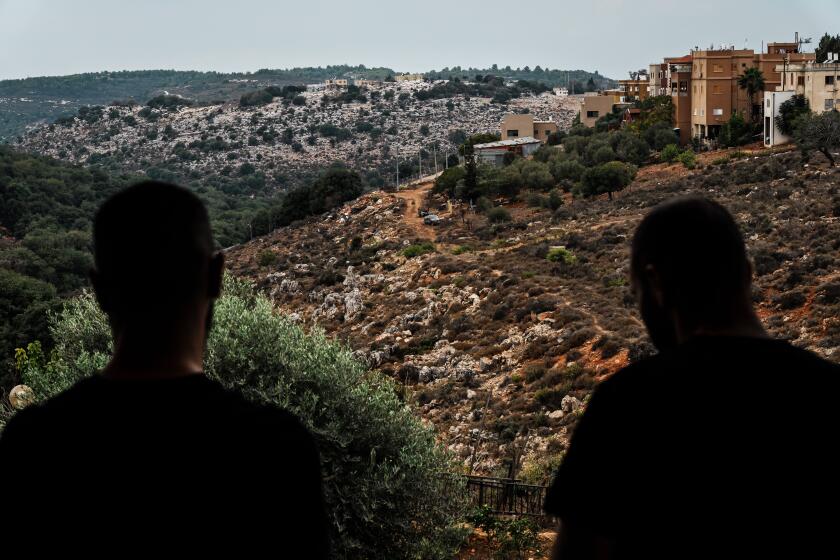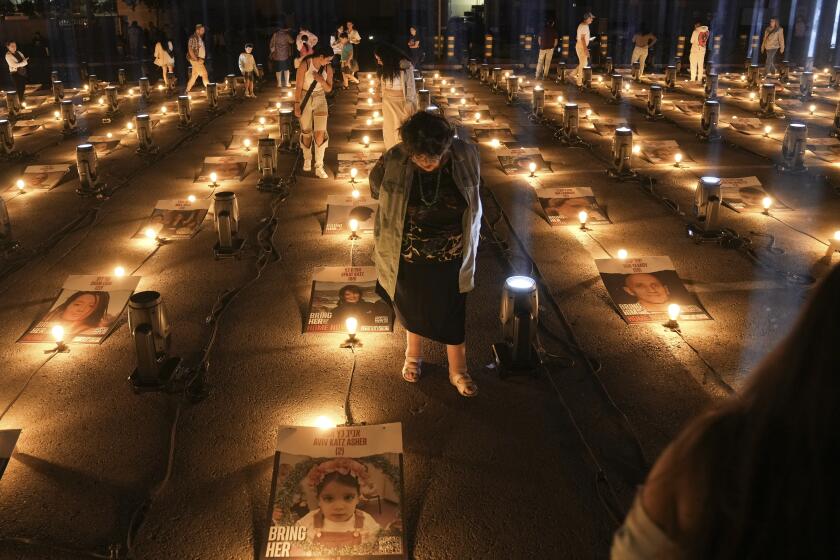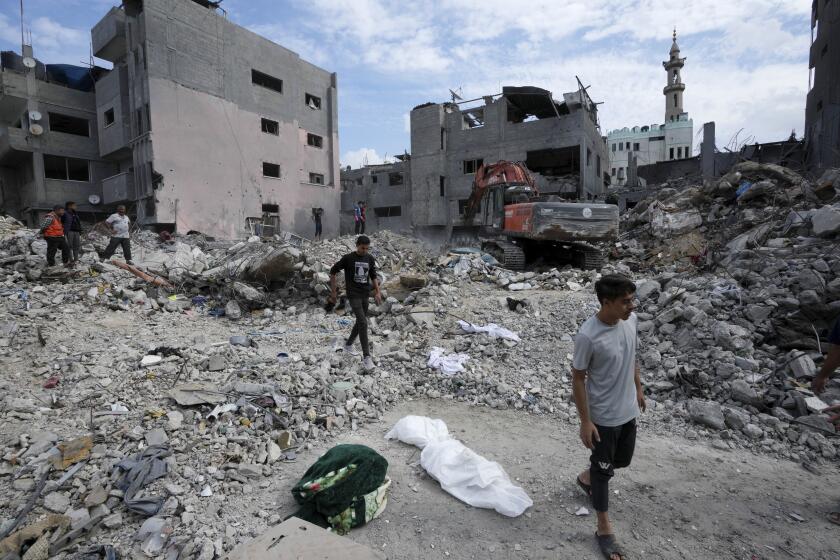U.S. seeks a delicate balance in responding to attacks on its forces by Iran-backed militias
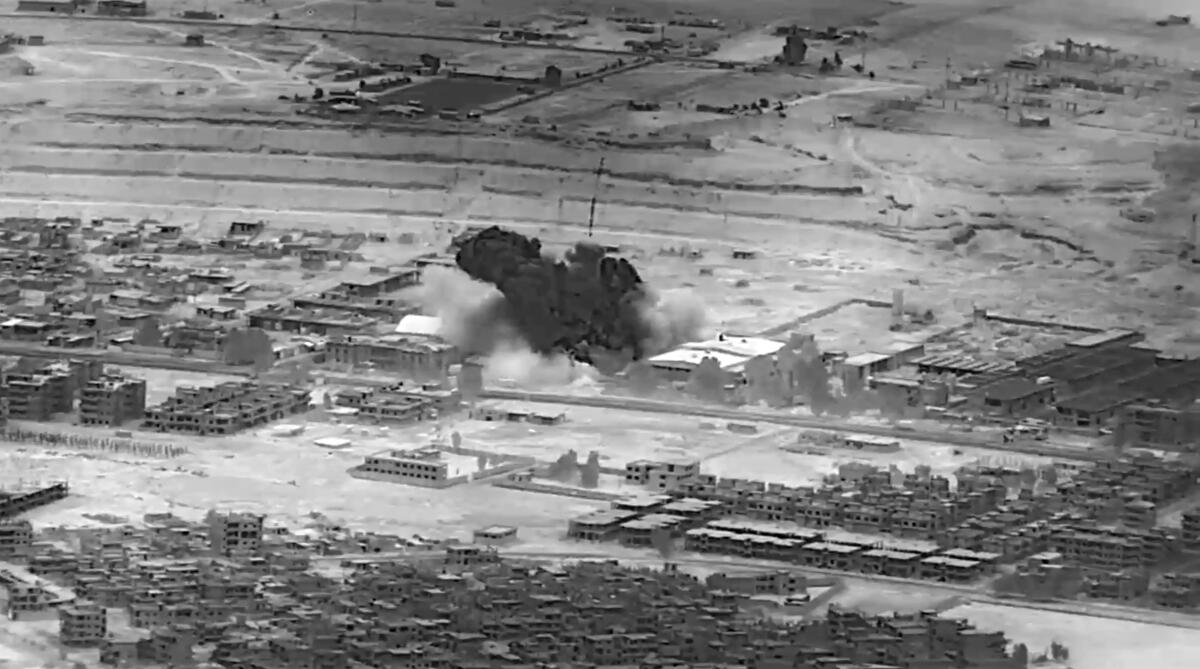
- Share via
WASHINGTON — Iranian-backed militants in Iraq and Syria have long battled with U.S. and coalition forces, launching sporadic attacks against bases in the region where troops are deployed to fight Islamic State militants.
But as civilian deaths in Israel’s war against Hamas began to skyrocket, there has been a dramatic spike in attacks by Iran’s proxies, operating under the umbrella name of the Islamic Resistance in Iraq.
While most of the more than five dozen attacks have been largely ineffective, at least 60 U.S. personnel have reported injuries said to be minor. Most often those have been traumatic brain injuries from the explosions, and all troops have returned to duty, according to the Pentagon.
In response to the attacks, the U.S. has walked a delicate line. The U.S. military has struck back just three times as the Biden administration balances efforts to deter the militants without triggering a broader Middle East conflict.
A look at the attacks and the U.S. response:
Attacks — when, where, why?
According to the Pentagon, Iranian-backed militants have launched 61 attacks on bases and facilities housing U.S. personnel in Iraq and Syria since Oct. 17. Of those, 29 have been in Iraq and 32 in Syria.
Lebanon-based Hezbollah is holding back from all-out war with Israel for now — but chances of a dangerous miscalculation by either side are high.
The U.S. has about 2,000 troops in Iraq, under an agreement with the Baghdad government, and about 900 in Syria, mainly to counter Islamic State but also using the Al Tanf garrison in the south to keep tabs on Iranian proxies moving weapons across the border.
The latest jump in attacks began 10 days after Hamas militants’ Oct. 7 attack inside Israel, where at least 1,200 people, mostly civilians, were killed and some 240 hostages taken, according to Israel.
Israel’s military response has killed thousands of civilians trapped in Gaza — officials there say more than 11,500 people have died — and fueled threats of retaliation by a range of Iran-backed groups, including Hezbollah in Lebanon, Yemen-based Houthis, and militants in Iraq and Syria.
Violence surges in the West Bank as Israel increases raids to root out militants. Palestinians say the military is using the war as an excuse to crack down.
Those threats escalated after an Oct. 17 blast at a Gaza hospital killed hundreds of civilians. Hamas blamed Israel for the explosion, but Israel denied it, and Israeli, U.S. and other officials have blamed it on a missile misfire by Islamic Jihad.
The bulk of the attacks on bases and facilities have been with one-way suicide drones or rockets, and in most cases there were no injuries and only minor damage. A significant number of the injuries, particularly the traumatic brain injuries, were in the initial attacks between Oct. 17 and Oct. 21 at Al Asad air base in Iraq and Al Tanf.
One U.S. contractor suffered a cardiac arrest and died while seeking shelter from a possible drone attack.
Who are these groups?
With a power vacuum and years of civil conflict following the 2003 U.S.-led invasion of Iraq, militias grew and multiplied in Iraq, some supported by Iran. A decade later, as the Islamic State extremist group swept across Iraq, a number of Iran-backed militias came together under the Popular Mobilization Forces umbrella group and fought Islamic State.
A month after Hamas’ surprise attack nearly brought Israel to its knees, the country’s battered ‘peace camp’ is rising — or trying its best to do so.
The groups included the Asaib Ahl al-Haq, the Badr Brigades and Kataeb Hezbollah, or Hezbollah Brigades — a separate group from the Lebanese Hezbollah. A number of the Iraqi militias also operate in Syria, where Iran supports the government of Bashar Assad against opposition groups in the uprising-turned-civil-war that began in 2011.
After the outbreak of the Israel-Hamas war, a group of the Iran-backed factions branded itself under the new Islamic Resistance in Iraq name, and began the latest spate of attacks on bases housing U.S. forces in Iraq and Syria.
A Times special correspondent in Gaza offers a personal account of living in a place where nowhere feels safe.
The attacks put Iraqi Prime Minister Mohammed Shia Sudani in a difficult position. While he came to power with the Iranian-backed groups’ support, he also wants continued good relations with the U.S. and has backed the ongoing presence of American troops in his country.
U.S. Secretary of State Antony J. Blinken, in a meeting with Sudani this month, warned of consequences if Iranian-backed militias continued to attack U.S. facilities in Iraq and Syria. Sudani then traveled to Tehran and met with Iran’s Supreme Leader Ayatollah Ali Khamenei, a meeting U.S. officials suggested was a positive development.
On Israel’s border with Lebanon, residents are worried that groups like Hezbollah will join a war that eventually spirals into a regionwide conflict.
An official with one of the Iranian-backed militias said Sudani put “great pressure” on the militias not to carry out attacks during Blinken’s visit. In return, he said, Sudani promised to push the Americans not to retaliate aggressively against militias that have carried out the strikes. The official spoke on condition of anonymity because he was not authorized to comment publicly.
Proportional or not enough?
Since the Oct. 7 Hamas attack, the Biden administration has moved warships, fighter jets, air defense systems and more troops into the Middle East in a campaign to discourage militant groups from widening the conflict.
But the U.S. military response to the attacks on its forces has been minimal.
On Oct. 27, U.S. fighter jets struck two weapons and ammunition storage sites in eastern Syria near Boukamal that were used by Iran’s Islamic Revolutionary Guard Corps and Iranian-backed groups.
On Nov. 8, fighter jets dropped bombs on Revolutionary Guard weapons storage facility near Maysulun in Dair Alzour. And on Nov. 12, U.S. airstrikes targeted a training facility and a safe house in the Bulbul district of Mayadin. U.S. officials said Revolutionary Guard-related personnel were there and probably struck, but provided no details.
Weeks after Hamas militants paraded her nearly naked body, young Israeli festival-goer Shani Louk is confirmed dead. Many families still await news of their loved ones.
There are concerns within the administration that more substantial retaliation could escalate the violence and trigger more deadly attacks. The Pentagon says the strikes have degraded the group’s military stockpiles and made the sites unusable.
But critics argue that the U.S. response pales in comparison with the 60 attacks and American injuries, and has failed to deter the groups.
Iraq government sensitivities
Though nearly half of the attacks have been on U.S. bases in Iraq, the U.S. has conducted retaliatory airstrikes only against locations in Syria.
The Pentagon defends the strike decisions by saying the U.S. is hitting Iranian Revolutionary Guard sites, which has a more direct impact on Tehran. Officials say the goal is to pressure Iran to tell the militia groups to stop the attacks. They also say the sites are chosen because they are weapons warehouses and logistical hubs used by the Iran-linked militias, and taking them out erodes the militants’ attack capabilities.
A key reason the U.S. is concentrating on Syria, however, is that the U.S. doesn’t want to risk alienating the Iraqi government by striking within its borders — potentially killing or wounding Iraqis.
Rescuers in Gaza don’t have the equipment, manpower or fuel to search properly for the living, let alone the dead buried among mounds of rubble.
In early January 2020, the U.S. launched an airstrike in Baghdad, killing Gen. Qassem Suleimani, the head of Iran’s elite Quds Force, and Abu Mahdi Muhandis, deputy commander of Iran-backed militias in Iraq. The strike frayed relations with the Iraqi government and spawned demands for the withdrawal of all U.S. forces from the country.
The U.S. considers its presence in Iraq critical to the fight against Islamic State, its ability to support forces in Syria and its ongoing influence in the region. Military leaders have worked to restore good relations with Baghdad, including providing ongoing support for Iraqi forces.
More to Read
Sign up for Essential California
The most important California stories and recommendations in your inbox every morning.
You may occasionally receive promotional content from the Los Angeles Times.
